One of the main advantages of a projector over a TV is that the image size is variable. Many can produce pictures of 300” or larger. This is bigger than you likely need (or even want) for indoor home theaters but makes them more suitable for outdoor use. While not all projectors are designed to work outside, there are a lot of great options that give you that versatility.
The best outdoor movie projector is one that’s bright, durable, portable, and easy to set up. All of the outdoor projectors on this list fit those criteria, but the BenQ LK936ST is the best all-around option, with an easy installation, super-bright lamp, and impressive image quality.
This doesn’t mean the BenQ LK936ST is the best choice for everyone, though (>>> Check on Projectorscreen.com). Before we get into the full product reviews, let’s break down the key specs to pay attention to when you’re shopping for an outdoor movie projector.
Best Outdoor Projector Options for 2023:
| Optoma GT1090HDRx | ViewSonic PX748 | Epson Pro EX10000 | Optoma UHD38 | BenQ LK936ST | |
|---|---|---|---|---|---|
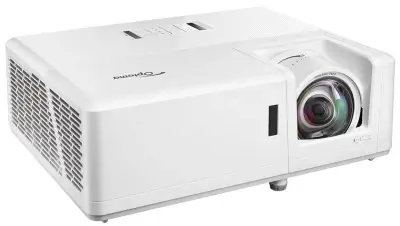
|
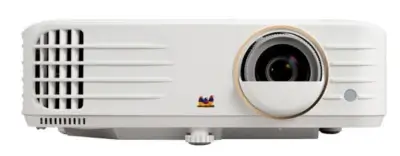
|
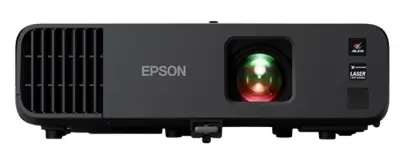
|
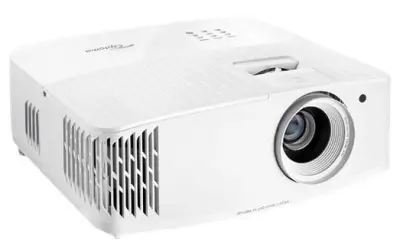
|

|
|
| Brightness (Lumens) | 4,200 ANSI | 4,000 ANSI | 4,500 ANSI | 4,000 ANSI | 5,100 ANSI |
| Resolution | 1920x1080 | 3840x2160 | 1920x1080 | 3840x2160 | 3840x2160 |
| Input Lag | 8.2ms | 4.2ms | No data | 4.2ms | 34ms |
| Screen size | 36" - 301" | 30" - 301" | 40" - 500" | 33" - 300" | 30" - 300" |
| Throw distance | 1.3' - 10.9' | 3.2' - 24.7' | 6.3' - 48.3' | 4.0' - 32.7' | 2.0' - 17.7' |
| Internal Speakers | 10.0 Watts × 2 | 10.0 Watts Mono | 16.0 Watts Mono | 10.0 Watts Mono | 10.0 Watts Mono |
| Price | BHPhotoVideo.com | BHPhotoVideo.com | Check on Amazon | BHPhotoVideo.com | BHPhotoVideo.com |
Full Reviews
Optoma GT1090HDRx 1080p Outdoor Projector
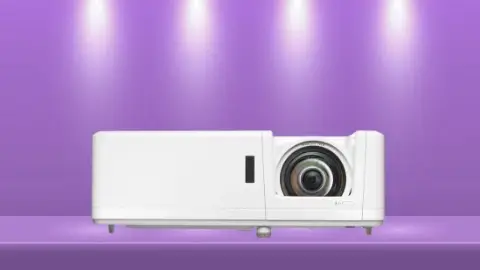
The versatility of the Optoma GT1090HDRx is its main strength. This starts with the spaces where it can be used. Its 4,200-lumen laser phosphor light source is bright enough you won’t need to wait until night time to use it, indoors or out.
Along with this, the short throw distance fills a 100-inch screen from around 4 feet away, and you’ll only need about 11 feet for a massive 300-inch image.
It also supports 360° installation with 2D keystone correction, so you can install it quickly and easily in any space.
The Optoma GT1090HDRx is just as versatile when it comes to what you can play through it. Its single-digit input lag makes it suitable for any style of gaming, even serious and competitive players.
For movies, it supports 3D content and has a 24p playback option to see older films in their original form. The only thing it can’t play is 4K content, though it does produce a high-contrast and lifelike full HD image for all styles of content.
The Optoma GT1090HDRx also has the durability for indoor/outdoor use. Its light source has a long average lifespan of around 30,000 hours, and isn’t as prone to breaking or issues as traditional lamps.
It also uses IP6X dust protection and is built to withstand 24/7 use. It’s also relatively compact, weighing just over 12 pounds, so you’ll have no problem moving it from place to place.
PROS & CONS:
Pros
- Powerful lamp suitable for even bright spaces
- Short throw distance
- Fast and flexible installation
- Compact and portable
- Great choice for gaming
Cons
- No 4K resolution
- No built-in wireless connectivity
Full review: Optoma GT1090HDRx
ViewSonic PX748 – Portable Outdoor Projector
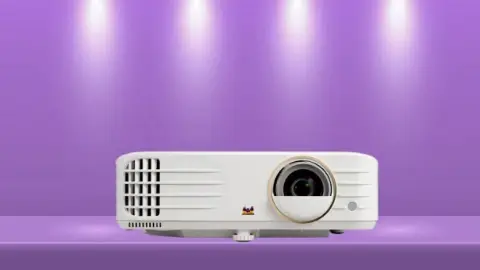
The first thing gamers will notice about the ViewSonic PX748 is its responsiveness. Not only does it have a super-low single-digit input lag for full HD content, this is paired with a phenomenal 240Hz frame refresh rate.
Together, these ensure you’ll catch all the action and make it a solid choice for even professional or competitive gamers.
Specifically for outdoor use, our favorite thing about the ViewSonic PX748 is its high brightness. Its 240-watt bulb puts out a uniform 4,000 lumens, bright enough to maintain a vibrant, saturated image even in outdoor spaces in the daytime.
It’s also easy to carry from place to place, weighing just over 6 pounds and with a slim 4.3” profile. The anti-warp, keystone correction, and zoom functions give users a good array of options for a fast, flexible setup.
The XPR technology in the ViewSonic PX748 produces a true 4K image with strong image contrast and realistic colors.
While it lacks built-in wireless or direct streaming capabilities, it has more wired content options than other projectors, and you can connect phones or tablets via USB to charge them while playing content, a helpful feature in a portable projector.
PROS & CONS:
Pros
- Sharp 4K resolution with high image contrast
- Super responsive and ideal for gamers
- Lightweight and portable
- Bright enough for daytime outdoor use
- Flexible installation
- Charges devices while playing content
Cons
- Subpar sound quality from built-in speakers
- No wireless connectivity
Epson Pro EX10000 – One of the Best Outdoor Projectors
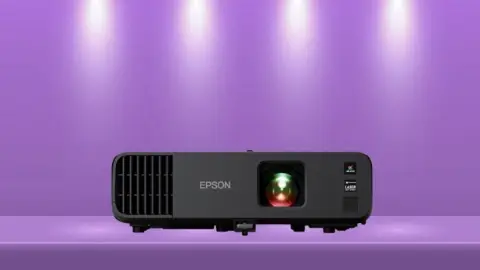
Here’s another excellent option from Epson. The Epson Pro EX10000 uses similar 3LCD-chip display technology to the LS500 above.
Its long-lasting laser light source puts out an impressive 4,500 lumens, making it one of the brightest projectors you’ll find. You can use it outside day or night and still get a saturated, detailed picture.
The Epson Pro EX10000 is the perfect projector for those who want the biggest possible screen. It can produce images up to 500”.
Granted, you’ll need a lot of space (59 feet) to get it, but the throw distance isn’t unreasonable at smaller screen sizes—around 10 feet for a 100” screen, or 29-35 feet for a 300” screen.
The manual focus, 1.6x zoom, and other image adjustment functions give it a relatively quick set-up process at all distances.
We also recommend the Epson Pro EX10000 for those who don’t have Wi-Fi in their outdoor viewing space.
Its connection panel has far more options than the 2 HDMI ports you’ll find on most outdoor projectors, including VGA, RCA, and USB inputs.
It has wireless connectivity, as well, and supports Miracast and Chromecast. That gives it a lot of versatility for use both indoors and out. Click here for our more in-depth Epson Pro EX10000 review.
PROS & CONS:
Pros
- Super-bright lamp
- Wide color gamut with no distracting image issues
- Supports Miracast for wireless screen sharing
- Screen sizes up to 500”
- Low-maintenance with 20,000-hour light source lifespan
- Robust connectivity
Cons
- No 4K support
- Needs a lot of space for larger screen sizes
Optoma UHD38 – Gaming Projector for Outdoor Use
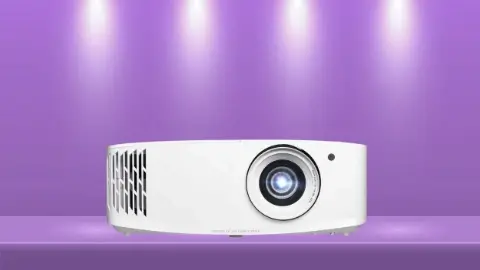
The Optoma UHD38 is a versatile projector capable of handling just about any type of content.
For home theaters, it has a true 4K resolution with HLG and HDR support, producing a sharp and realistic image that faithfully recreates the source material.
It also has full 3D support, as well as a low 4.2ms input lag and high 240Hz frame refresh rate for gaming. That low input lag applies to Ultra HD content, too, with an input lag of just 16.7ms for 4K.
This is also a great choice if you want the option of daytime viewing outdoors. Its 4,000-lumen lamp is powerful enough you won’t need to wait for full dark to watch backyard movies.
As far as portability, while it’s not the lightest projector on the market it’s still very easy to move from place to place, weighing less than 10 pounds and with relatively compact overall dimensions.
The only weak area of the Optoma UHD38 is its throw distance and setup. While it does have 2D keystone correction for squaring the image, its lack of anti-warp or lens shift features, as well as its narrow zoom, make it a bit more finicky in terms of placement.
Its throw distance is also on the longer side, making it best used in relatively large, open spaces. Our more in-depth review of the Optoma UHD38.
PROS & CONS:
Pros
- Sharp Ultra HD resolution
- Vibrant color with high contrast
- Bright lamp suitable for any light level
- Low input lag for full HD or 4K gaming
- Full 3D compatibility
Cons
- Limited image alignment options
- Long throw distance
BenQ LK936ST – Best Outdoor Projector for a Bright Image
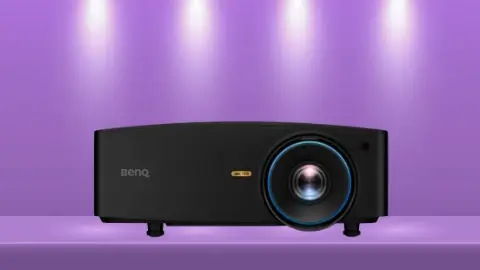
The BenQ LK936ST checks just about every box when it comes to what people look for in an indoor/outdoor projector.
Not only does it display 4K content in its full detail, it upscales full HD or lower content to nearly 4K quality.
Add in the high image contrast and strong color performance and you’ll get a true-to-life image at all screen sizes.
That image will stay clear and colorful in any light level, too. The zero-deviation alignment of the LK936ST’s laser diode array improves the light efficiency, giving it the highest brightness on the list.
It also has a relatively short throw distance, needing around 6-7 feet for a 100-inch image, with a 3D keystone and corner fit correction that supports off-center installation with 360° rotation.
The digital shrink and shift options give users more ways to fine tune the image to perfectly fit their screen.
Smart home owners will appreciate how easy it is to integrate the BenQ LK936ST into home automation routines, and it can even be managed and controlled through a phone or tablet.
Just about the only place this projector falls short is responsiveness. Its input latency is above the 30ms threshold most gamers look for, so while you can use it for casual play it’s not a great choice for fast-paced games or serious players. Click here for our more in-depth review of the BenQ LK936ST.
PROS & CONS:
Pros
- True 4K resolution with upscaling
- Excellent image color and contrast
- Powerful light source works in any light level
- Flexible installation and alignment options
- Integrates easily into smart home systems
Cons
- Input lag is high for gaming
- High cost
Outdoor Projector Buying Guide
The Most Important Features to Consider When Buying an Outdoor Projector:
Set-up Ease
In a home theater, you can permanently install your projector and only have to set it up once.
You don’t want to leave electronic equipment like projectors outside all the time, though. You’ll likely need to set it up every time you want to use it, and that means a quick, easy set-up is especially important.
Image adjustment features like keystone correction and lens shift are helpful in outdoor set-ups, where you may be dealing with sloped terrain and may not be able to control the projector’s height.
Other options like zoom and lens shift can help with the fine-tuning of the image, getting you up and running faster when it’s time for a backyard movie night.
Projector with the easiest set-up: BenQ LK936ST
Portability
Some home theater projectors are too delicate to be constantly moved from place to place, especially those that use traditional lamps for the projection.
Others are durable, but heavy and bulky, which is annoying at best and, at worst, increases the likelihood of drops and other damage.
The best outdoor projector is both lightweight and rugged, allowing you to take it outside easily and not worry about it breaking in the process.
Most portable projector: ViewSonic PX748 (6.2lbs)
Brightness
You can control the light level in an indoor home theater, but that’s not always the case when you go outside.
Even at night, those who live in urban areas especially will have some light pollution to contend with. That makes a bright lamp even more important than it is for many indoor applications.
A brightness of at least 3,000 lumens is a requirement for outdoor use. In this context, brighter is definitely better, especially if you don’t want to wait for the sun to go down to start your movie.
Brightest projector: BenQ LK936ST
Throw Distance and Image Size
You might think throw distance isn’t an issue outside—after all, where else can you get that kind of uninterrupted space? The issue is that, with no ceiling, it’s harder to have an elevated projector set-up.
This makes it more likely people, animals, and other objects will pass between the projector and the screen, interrupting the movie. With a shorter throw distance, that’s less space you need to keep clear.
Generally speaking, you’ll also want a larger image outdoors than you use inside—and the larger the image, the more space you’ll need to get it.
A combination of short throw ratio with large maximum screen size is the best for an outdoor movie projector. Find the top outdoor projector screen picks.
Best throw distance and size combination: Optoma GT1090HDRx (301” image at 10’11”)
The Verdict
We said at the beginning that the BenQ LK936ST is the best overall outdoor movie projector (>>> Check on Bhphotovideo), but as you can see it’s not the winner in each category.
The Epson Pro EX10000 is a great choice for those who want the largest possible image, while the short throw distance of the Optoma GT1090HDRx is ideal for tight spaces or tricky installations, and gamers will love the low latency of the ViewSonic PX748 or Optoma UHD38.
Whichever way you go, we hope this review has helped you pinpoint what’s most important for your outdoor movie projector. Whether you’re looking for the shortest throw or the best picture quality, one of the six options above will fit your needs.
FAQs
That depends on your situation. An indoor screen can work in outdoor environments, too, provided you have a place you can hang it.
That said, you won’t want to use an indoor screen in a permanent outdoor installation, since they’re not designed to stand up to sun, wind, rain, and all the other things outdoors that can cause damage.
Many people also want a larger screen outdoors than they would inside. You can find a variety of inflatable, self-standing outdoor screens that will work well with any of the projectors on this list.
In an outdoor setting, yes, that’s a smart idea. All of these projectors have some kind of speakers built in, but they tend to max out around 20 watts of power.
That’s simply not enough to keep the dialogue and other sounds audible over the extraneous noise that will exist in any outdoor space.
On the plus side, all of these outdoor projectors have an audio output through either a 3.5mm jack or optical port, so connecting external speakers is a breeze.